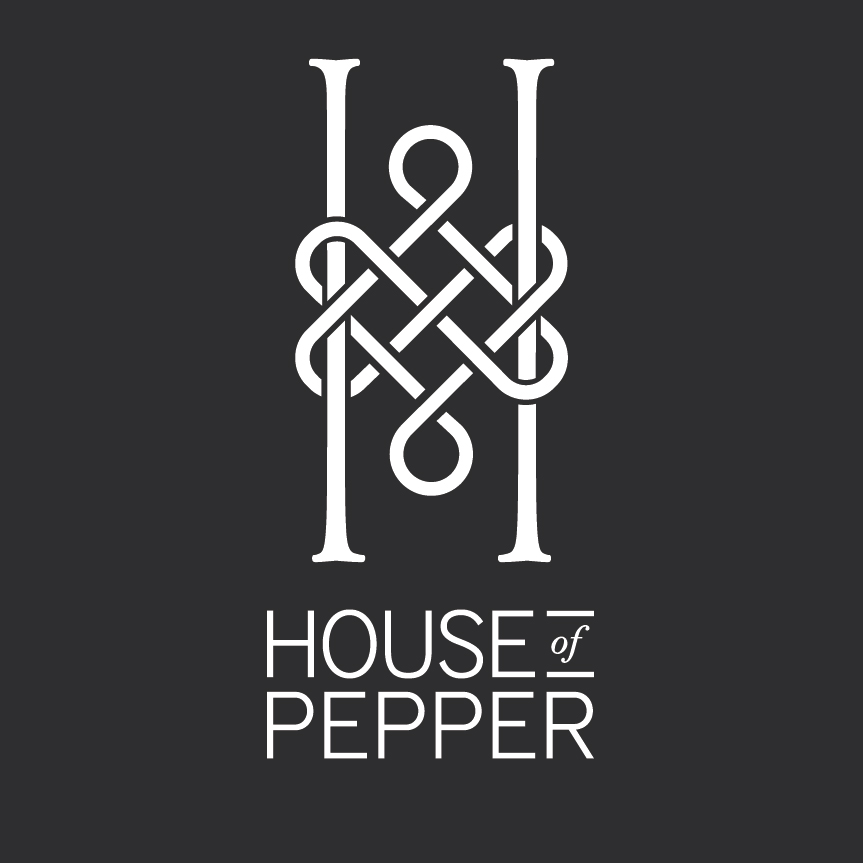Pictish Symbols found on Stones
There is nothing like a mystery! Symbols we cannot read, and abstracted designs found on standing stones in the fields of Scotland. This is the mystery of Pictish art.
There is nowhere else in Europe where these ancient symbols can be found. Significantly this art is before the influence of the Romans and the Christian church and before the arrival of St. Columba in 563 AD to Iona, Scotland.
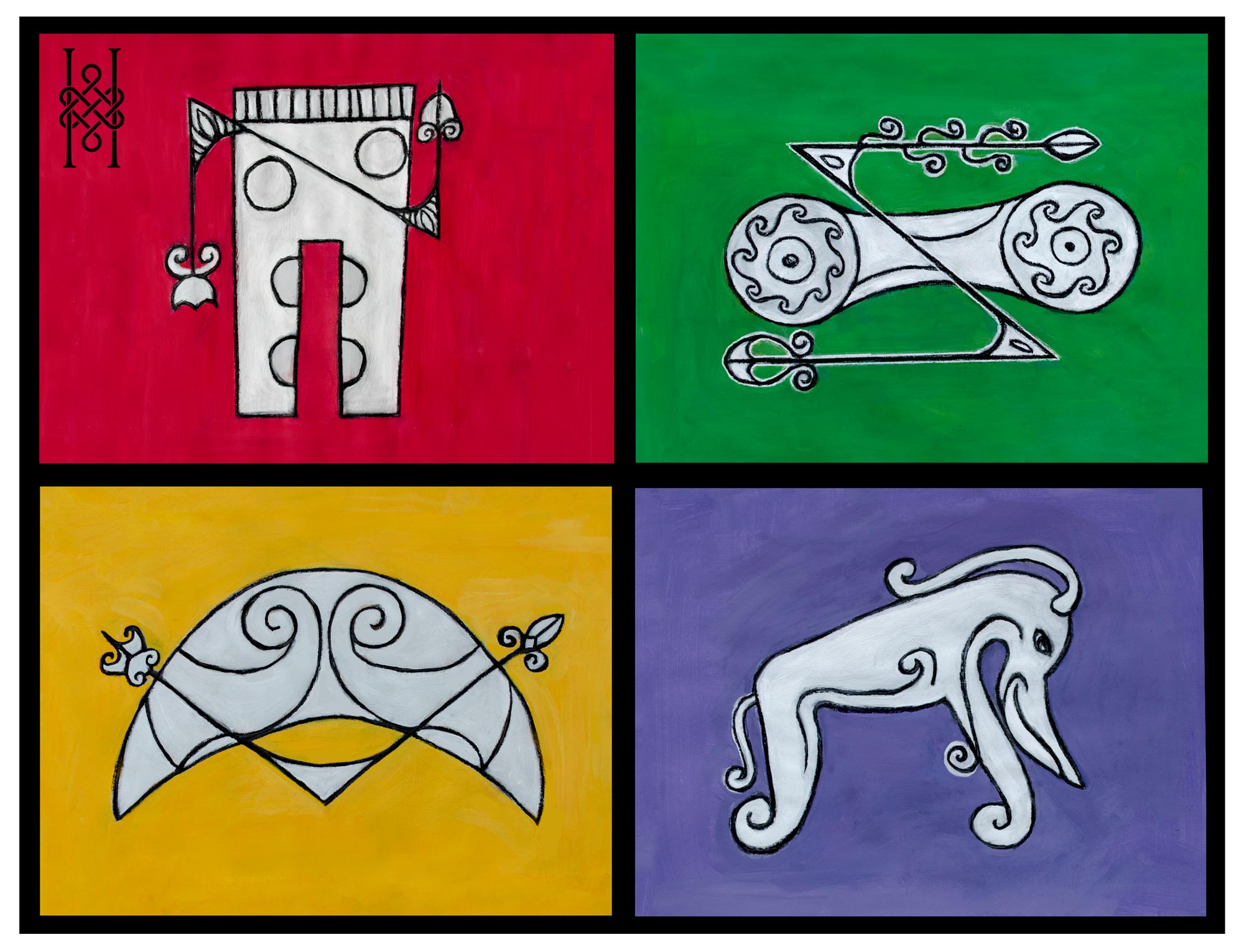
This unique art stands by itself. It is not just decorative, but formal and abstract. It is so different from anything else found at that time. The iconography is entrenched and strong, but the legacy of the Picts is sadly limited to about 300 stones across the north of Scotland.
The chosen examples are mostly from Class I Stones as classified by J Romilly Allen and Joseph Anderson in 1903 and date from the 6th to 8th centuries. Class I Stones are purely Pictish and Class II and III are a mix of Celtic Christian and Pictish.
Class I Stones are irregular standing stones with incised symbols. They do not show the influence of the Romans or the Christian Church. The Class I Pictish Stones were before the time of the illuminated manuscripts and Celtic knotwork and interlacing patterns as portrayed in the Book of Kells. It was not until the 8th century that the Celtic Christian Cross appeared on the Stones and they have been classified as Class II Stones.
Strangely the Picts as a people simply disappeared but I am guessing that there are descendants with Pictish blood running through the veins somewhere. A unique culture and language was forgotten and lost like the people. The repetition of the same symbols however, in different places and on different Stones suggests that there was a visual language of some kind, not necessarily an alphabet like Egyptian hieroglyphs as pictograms but as messages to the people of the day. Maybe the standing Symbol Stones were family totems or markers of territories or community meeting places in the countryside.
The Picts of Scotland have left us images but no words, no written history. They are assumed to be the descendants of the Caledonii and other Iron Age tribes and they occupied the area north of the Forth and Clyde estuaries in the first millennium AD.
1. Craw Stone
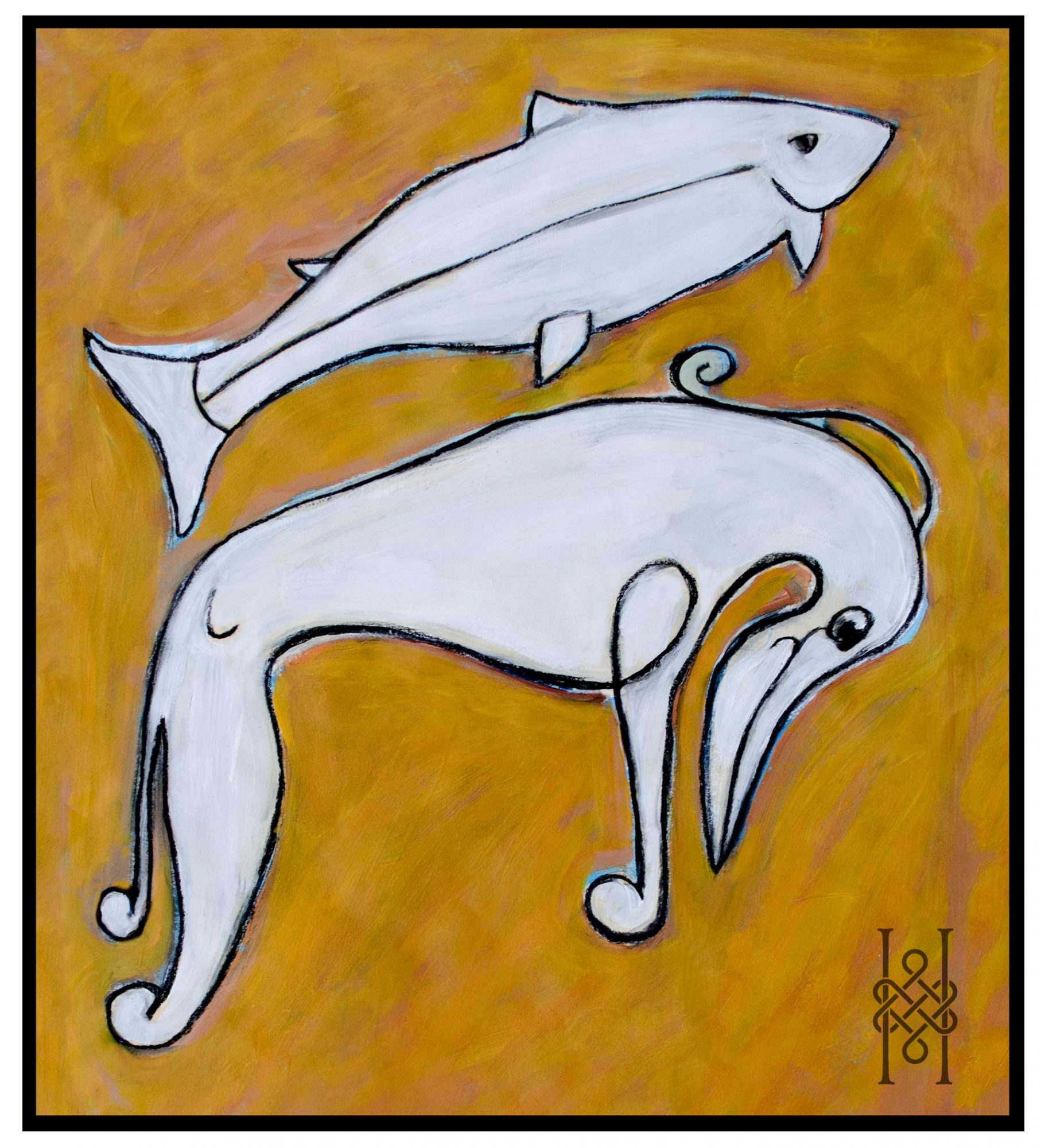 Craw Stone symbols, Aberdeenshire
Craw Stone symbols, Aberdeenshire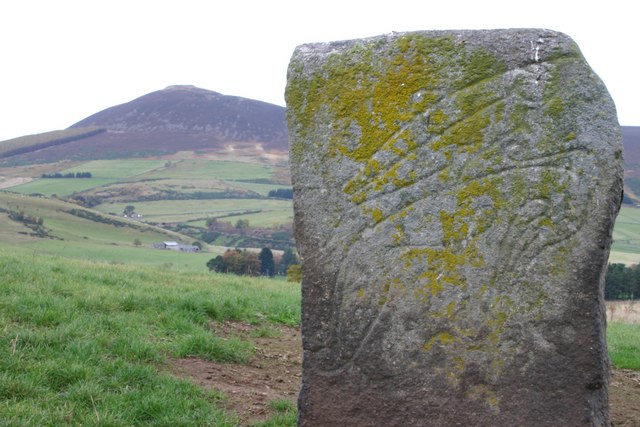 Craw Stone Photo Ray Berry
Craw Stone Photo Ray Berry
The Craw Stone at Rhynie in Aberdeenshire has a Salmon and Pictish Beast outline on the face of solid rock. When the animal cannot be identified it is classified as a beast.
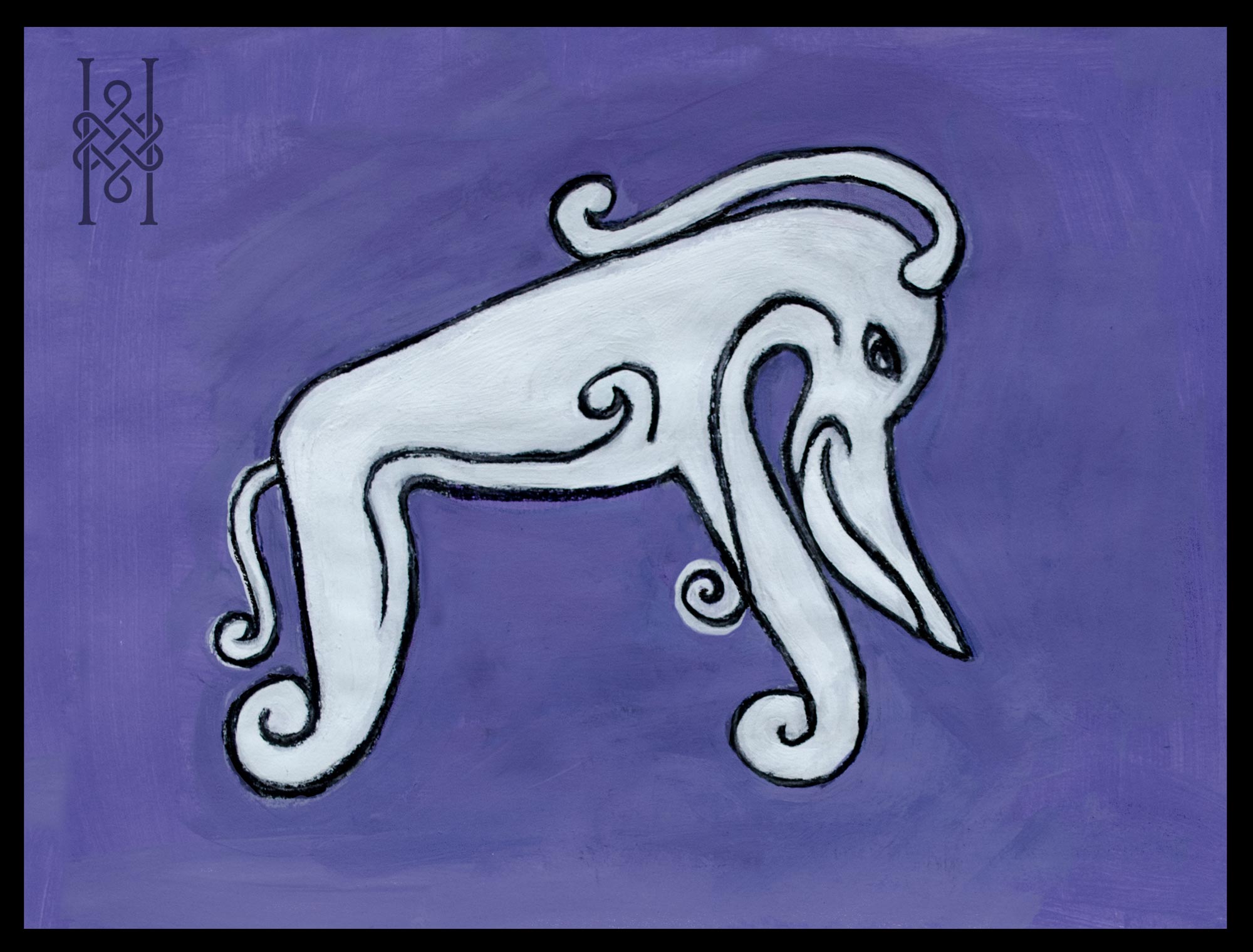
The salmon is the supreme ruler of the waters and would have been food for the Picts. We know that the fish is known in Irish myth as the Salmon of Knowledge and symbolizes the gaining of knowledge and wisdom, but; the Picts were not Irish. If they are both water creatures it might suggest that the beast could be a dolphin, but it has the beak of a duck and legs and tail of a land creature and possibly the top knot of a bird. A strange creature indeed. The Salmon is placed above the beast and as such in the hierarchy makes the fish more important, but it may have been a placement by the artist due to the undulations of the stone, unlikely but possible. The Pictish symbols do not appear to have had mandatory locations on the Stones as they varied from one to the next.
Some believe that the strange beast could be a popular fantastic creature like an elephant or even a seahorse or sea monster, or maybe a kelpie– a shape shifting water creature. This Pictish beast symbol was popular and copied almost exactly on other stones and sometimes tipped anti-clockwise into a more upright position. When tipped the elephant symbol would stand on a spiral hind leg and have a trunk like a duck’s beak. If not an animal from the real world then maybe this beast is from the imagination of the artist.
2. Picardy Stone
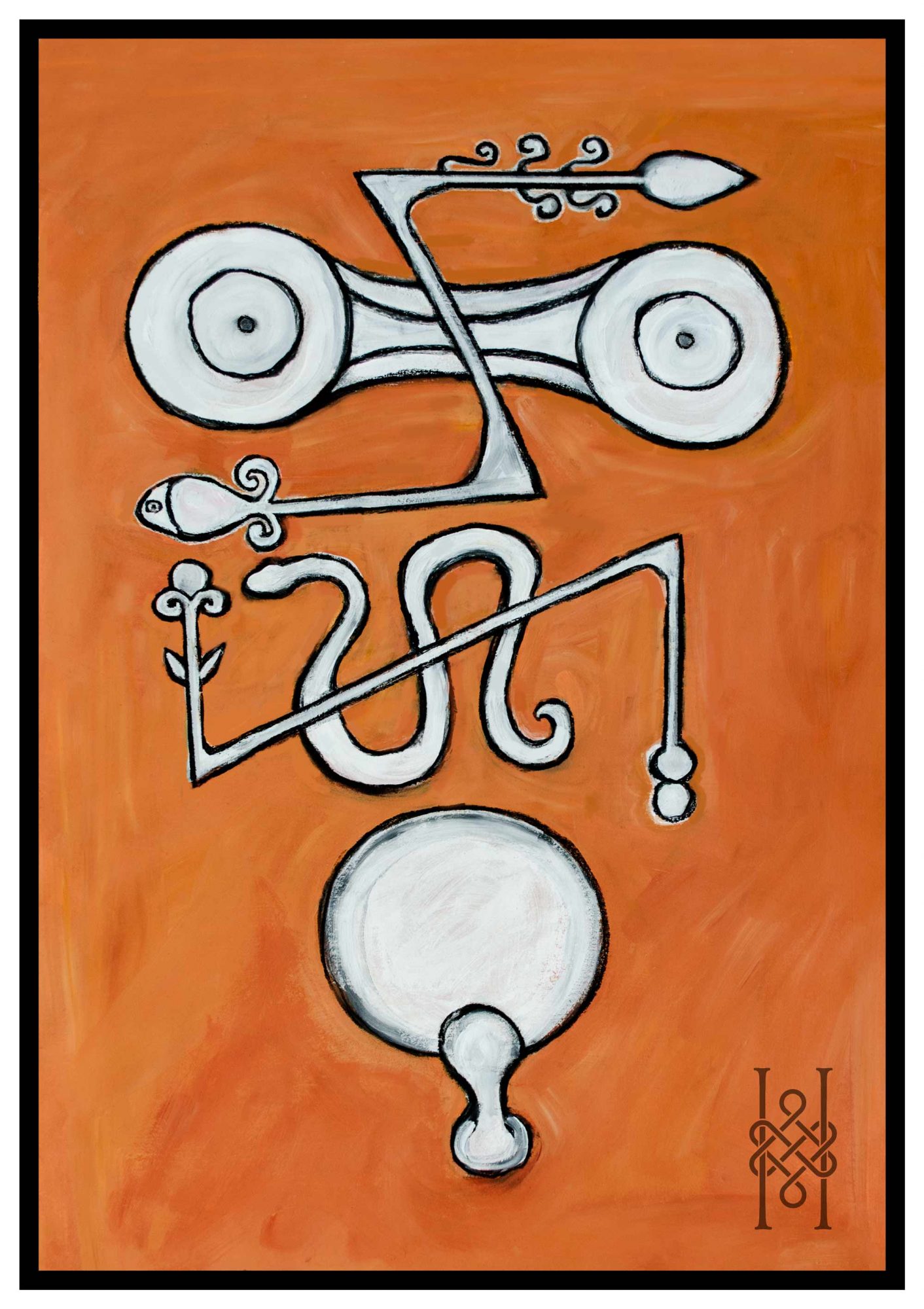 Picardy Stone with Pictish Symbols
Picardy Stone with Pictish Symbols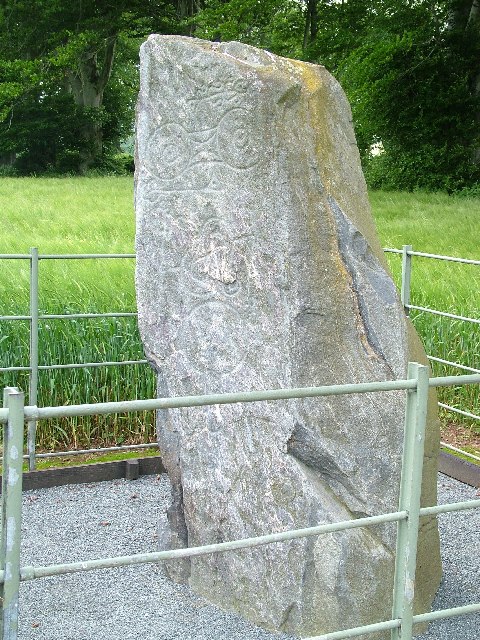 Picardy Stone Photo Greg Stringham
Picardy Stone Photo Greg StringhamThe Picardy Stone which is located South of Huntly in Aberdeenshire is one of the earliest Pictish carved Stones and dates to about 600 AD. There are three sets of symbols one above the other. At the top is the Double Disc with the Z Rod, in the middle is the Serpent with the Z Rod and at the base is the Mirror.
The Double disc at the top is balanced and symmetrical and sometimes thought to represent the Sun’s transition from Winter to Summer.
The Double Disc with Z Rod shown below is another variation of the same symbol. The discs are even and joined. The Z rod is superimposed but joined at the crossbar of the discs by two curved lines. The Z Rod is not always present with the double discs. Often the discs are filled with patterns like spirals; perhaps suggesting cogs in a wheel.
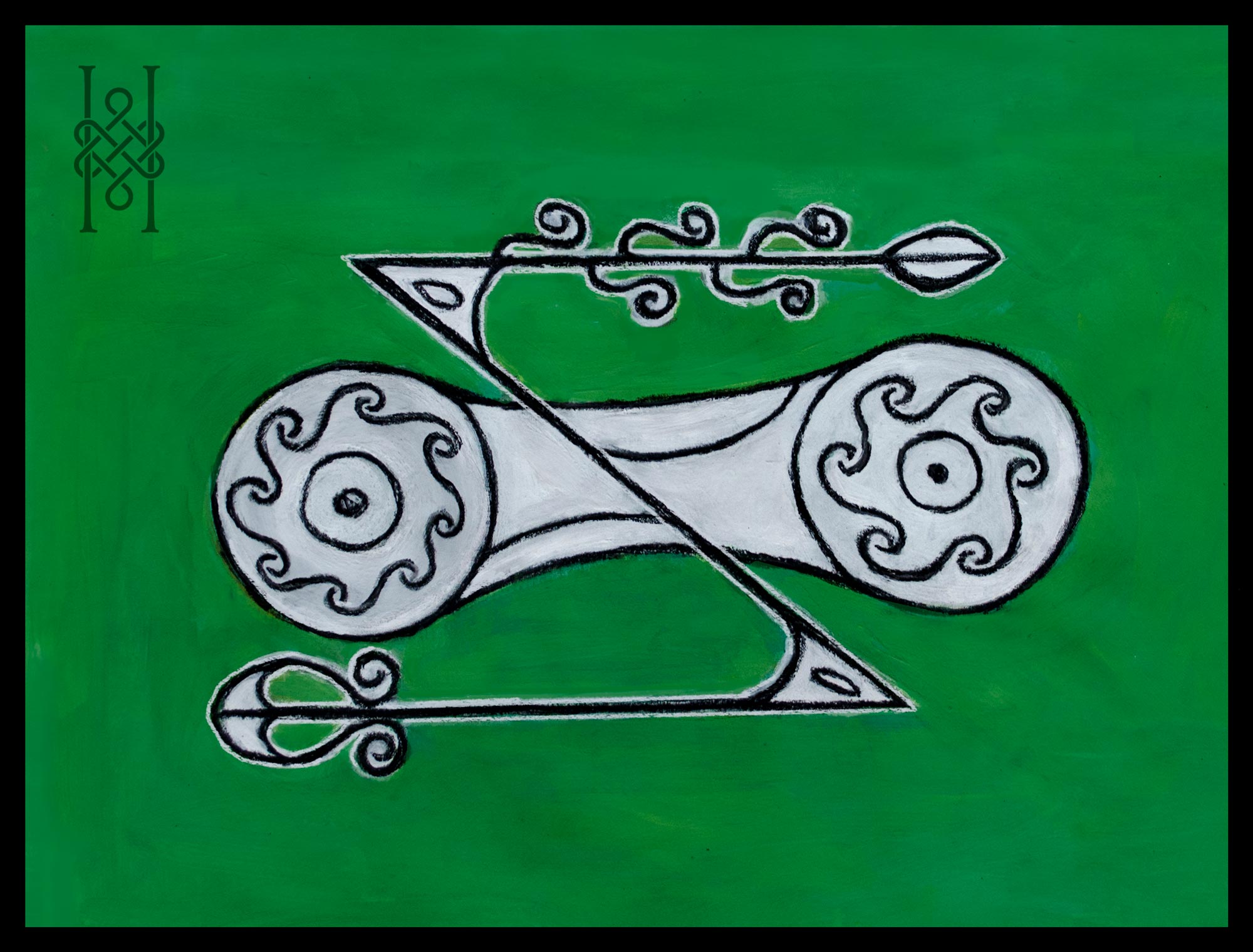
The Double Disc can have a multitude of meanings because it can be attached to bipolar thought and be a metaphor for life and death, dark and light, female and male, north and south, good and evil etc. It can be a design for an idea or concept or something visible and real like the Sun and Moon.
The backward Z Rod is balanced as two horizontals and a diagonal. The horizontal lines have been decorated with spirals and tip endings. Some believe the Z rod represents a broken arrow or a sword. The Rod could indicate direction and point left or right. A diagonal adds movement as a descending or ascending line and the true horizontal represents the horizon or a calm and inactive state. We do not know for sure what the Z Rod means. We can only guess.
In the second layer of the Picardy Stone is a serpent with two body bends. The Z Rod has been tipped to look like an N and is superimposed with spirals on the ends as finials. In Scotland there are few snakes but the Adder is venomous and called the serpent. Perhaps it is a warning that the snake is in the surrounding territory or a spiritual sign of rebirth with the shedding of the skin as in pagan beliefs.
In the bottom layer is the Mirror, sometimes shown with a Comb. The Mirror is often shown in combination with other symbols but particularly with the Double Disc and Z Rod. This symbol is also found in the later Class II Stones.
I think a mirror can represent many things including attention to appearance and bathing. It can be a reference to the self and the idea of reflection which invites examination of the face or perhaps an examination of life as projected by Socrates. It could be a feminine reference to beauty. Some believe that the serpent, the salmon and the mirror on these early stones symbolizes fertility and earth wisdom. The serpent, salmon and mirror are real objects that we can see. The Double Discs are abstracted from geometry and perhaps relate more to thinking and ideas. It is confusing to jump from the idea’s world to the natural world to try to interpret the meaning.
People tend to read the symbols separately when it is possible that they could represent three streams that are connected as one. A triple like the cosmos, the natural world and self or perhaps the spiritual realm, the mind, and the body.
3. Serpent Stone or Aberlemno Stone
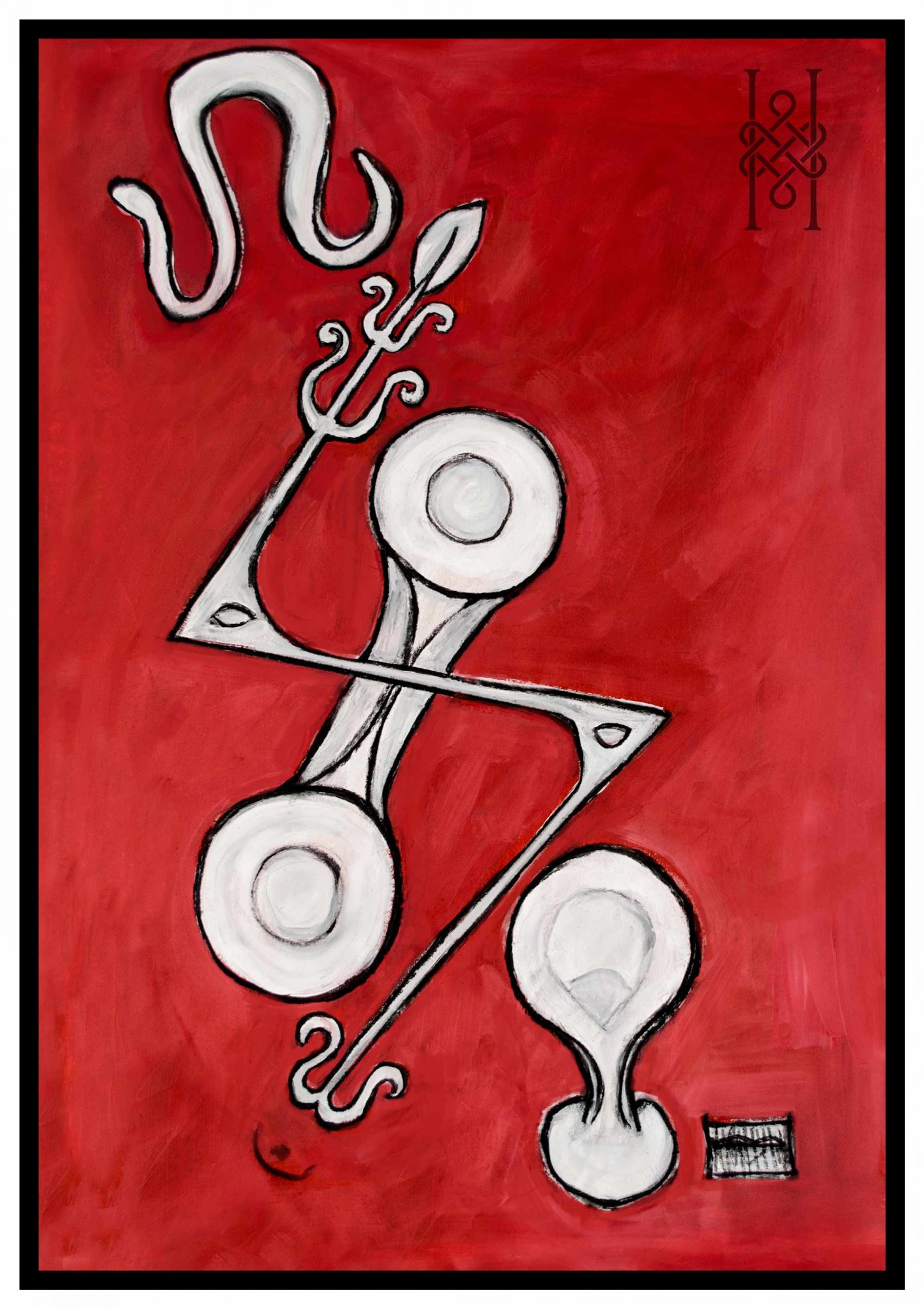
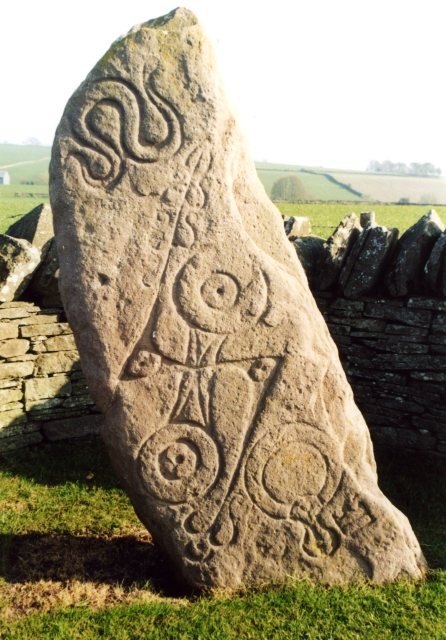
This photo shows the strong and bold linear carving of the sculptor. It is the most beautifully preserved stone of all the Pictish stones and stands where it was carved. Typical of early Pictish stones and dating from 600 AD, it may be associated with a burial.
This stone and is found beside the road in the village of Aberlemno. On the lower part of the back of the stone are small cup marks possibly indicating that it was erected in Neolithic times and carved later by the Picts. This is a Class I unshaped irregular stone and shows the Serpent, the Double disc and Z Rod and the Mirror and Comb symbols.
The symbols for me are connected and balanced carefully in the space they occupy. It seems that the design is carefully laid out across the stone in an opposite diagonal to the actual lean of the stone. Beautifully positioned and placed symbols on the stone face. No accident that the smaller serpent with one body bend fits at the top of the tapering stone. If all the parts could be seen as one then the Z Rod takes the eye from the mirror to the serpent at the top by crossing over the double disc in the middle. This is not like the graphic art of a road sign pointing where to go. For me this is much more than that and there is a beautiful directional flow and balance that joins the symbols. The sculptor’s incisions have strength and purpose, and the beautiful lines have lasted over one thousand years.
4. Comparing the Two Stones
 Picardy Stone with Pictish Symbols
Picardy Stone with Pictish Symbols
Before moving onto the last two Pictish symbols I have placed the Picardy and the Serpent Stones next to each other so you can see the repeating motifs and compare the layouts. Both have the serpent, the double disc and the mirror but in a different order. One set of symbols has been placed in horizontal bands (Picardy Stone) while the other is more diagonal. The Picardy Stone is granite and the Serpent Stone is red sandstone. Different textural qualities and degrees of difficulty for carving.
The serpent varies with one bend and two bends and is placed in different locations. One has a Z Rod. The mirror on one has a comb beside it. The arms of the Z Rod are extended as diagonals in the red rectangle and as a rotated Z in the brown rectangle above. All the Pictish Symbols were executed in the same way, but the designs varied slightly. Maybe different sculptors working with different stones and irregular surfaces produced different results. Regardless of this it does indicate that there was a common visual language by the repetition signalling something.
5. Crescent with V Rod
Finally, I will mention two more Pictish symbols that appear on Class II Stones with a mix of Pictish and Christian symbols.
In the yellow square is the Crescent with V Rod symbol. The V Rod is often overlaid, and the semi-circle crescent may be filled with spirals or key pattern designs. Here there is a simple curvilinear design.
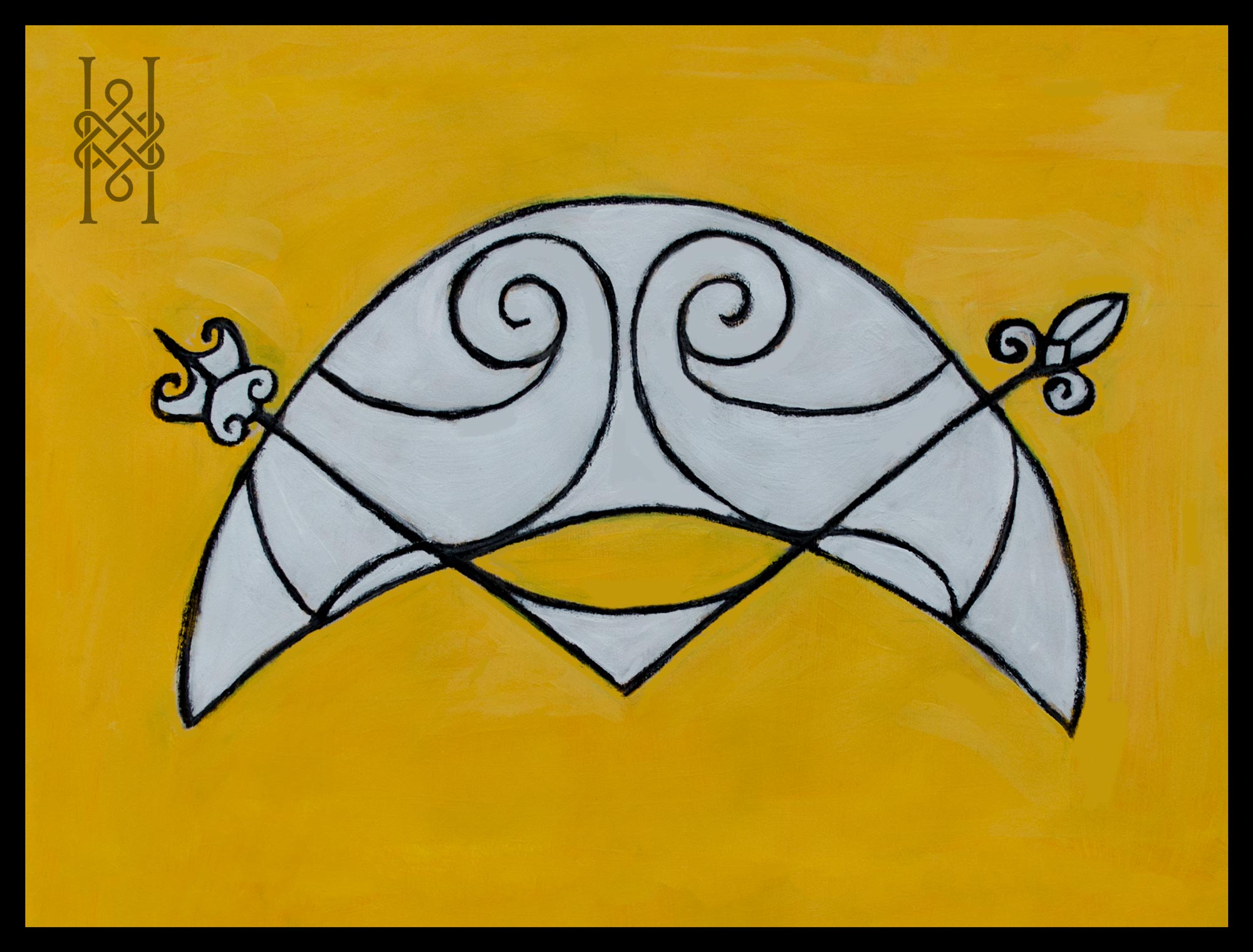
This Pictish symbol can be found on an upright Class II Celtic Cross slab called Aberlemno 3. On the reverse side with the Celtic Cross design there are interlaced animals and angels.
On the Pictish side there is a Crescent and V Rod symbol with intricate interlace and key patterns and a Double Disc and Z Rod and then a hunting scene and centaur below. The more simplified Crescent and V Rod designs like the one shown in the yellow square can be seen on the Clynekirkton Stone and many others.
It is thought the arc shape could be a symbol for the Moon. The geometric design is balanced and symmetrical and again the finials have scrolls and spirals.
6. Notched Rectangle with Z Rod
The last symbol in the red square shows an example of a Notched Rectangle with a Z Rod.
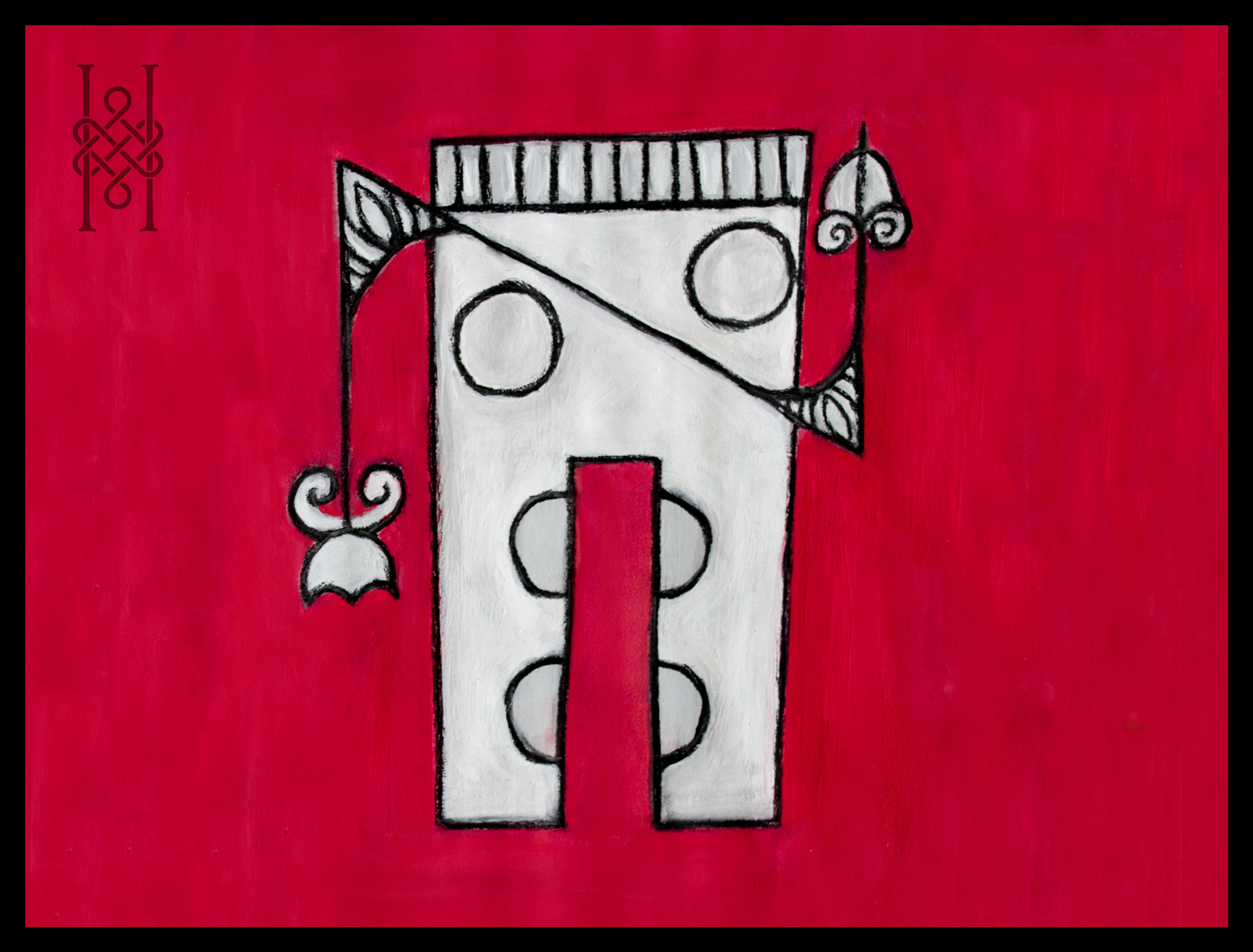
This Pictish Symbol can be found on the Dandaleith Stone in Craigellachie. It is pink granite, and also has the Crescent and V Rod. Another example can be found on the Maiden Stone or Drumdurno Stone near Inverurie which also has the Great Beast. It is a Class II Stone with the Celtic Christian Cross on the other side.
The Z Rod has been tipped and placed over the object to look like an N. The notches are the cut-out shapes and some think the (white) cut out rectangle represents a chariot. There are spirals and curls on the flame like finials.
Pictures Tell Stories
All the Pictish symbols were probably painted in colour on the Pictish Stones. We can only imagine what they would have looked like. The reality is that the ancient carved stones that remain in Scotland have an aura and energy around them; perhaps because we ourselves respect their resilience and longevity. Surviving the erosion and weather over the centuries is remarkable. There is enough left of the original incised designs to give us a few clues, not only about the images but about the Pictish people. They were called the Picture People and they did have pictures on their bodies it seems.
Written history is not the only history for me. There is a history of human life over the ages and it is told in pictures. It is found on rock faces and in caves or buried underground or hidden by vegetation or standing as great Stones in circles or as monoliths overlooking the land. Today some of the history is preserved in galleries and museums and some of the history can be patched together from stories, music, mythologies and legends passed down from one generation to the next. Some of the mystery surrounding the Picts can be brought to life from the Pictish Symbol Stones.
No matter what the answers may be and what the symbols may have said to the Pictish people at the time; the underlying force was the need to communicate. Even the artist working away in solitude is making works to share with others. These Pictish Stones talk to us from centuries past. Although the secrets and the mystery remain, we nonetheless can still appreciate the beauty without any words.
